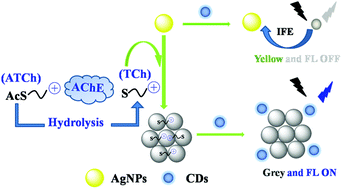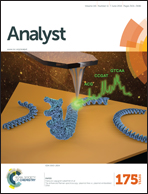Carbon dots-assisted colorimetric and fluorometric dual-mode protocol for acetylcholinesterase activity and inhibitors screening based on the inner filter effect of silver nanoparticles†
Abstract
In this work, we proposed an original and versatile dual-readout (colorimetric and fluorometric) protocol by means of silver nanoparticles (AgNPs) and fluorescent carbon dots (CDs), which was amenable to rapid, ultrasensitive assay of acetylcholinesterase (AChE) activity and its inhibitors. The sensing mechanism was based on the non-fluorescence state of CDs resulting from the inner filter effect (IFE) of AgNPs and the specific AChE-catalyzed hydrolysis of acetylthiocholine (ATCh) into thiocholine (TCh). Herein, the generated positively-charged and thiol-bearing TCh at trace concentration levels could trigger the aggregation of AgNPs through the well-known electrostatic and Ag–SH interactions, thereby turning the sensing solutions grey and recovering the IFE-quenched fluorescence simultaneously. Furthermore, the existence of IFE mechanism was conceivably confirmed by combining the zeta potentials, fluorescence spectra, UV-vis spectra, fluorescence lifetime and TEM measurements. As far as we know, the present study has reported the first dual-mode proposal for assessing AChE activity by using a CDs-based IFE sensing strategy, where the detection limit was as low as 0.021 mU mL−1 and 0.016 mU mL−1 by colorimetric and fluorometric measurements, respectively. On the other hand, the proposed assay was feasible to screen AChE inhibitors such as tacrine and carbaryl. Meanwhile, this rationally designed dual-mode sensing platform featured simplicity, rapidity, flexibility and diversity, which was demonstrated by the quantitative detection of spiked carbaryl in apple juice samples with satisfactory results.


 Please wait while we load your content...
Please wait while we load your content...